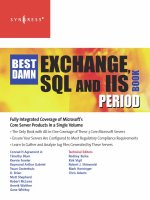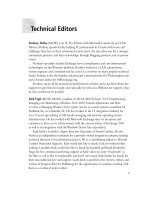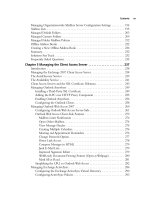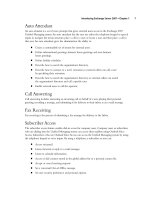Exxhange SQL And IIS- P14 potx
Bạn đang xem bản rút gọn của tài liệu. Xem và tải ngay bản đầy đủ của tài liệu tại đây (280.02 KB, 5 trang )
32 Chapter 2 • Installing Exchange Server 2007
■
Remote procedure call (RPC) over Hypertext Transfer Protocol (HTTP) Proxy Windows
networking component (required only if you are deploying clients that will use the
Outlook Anywhere functionality, previously called RPC over HTTP)
■
ASP.NET v2.0
In addition, if you’re planning to use OWA 2007 in your organization where you have
non-English domain controllers, it’s important you install the hotfi x mentioned in MS KB article
919166; otherwise you’ll experience issues in looking up recipients in the GAL using OWA 2007.
Hub Transport Server
No additional Windows components are required by the Hub Transport server; however, you
must make sure that the SMTP and NNTP services are not installed.
Edge Transport Server
The following components are required for the Edge Transport server:
■
ADAM
■
Like the Hub Transport role, SMTP and NNTP must not be installed
NOTE
ADAM is an included Windows component of Windows Server 2003 R2. However,
to install ADAM on a Windows 2003 server with SP1 or higher, you will need to
download the ADAM installation package separately. You can download ADAM
by clicking Active Directory Application Mode in the Downloads section of the
following link: www.microsoft.com/windowsserver2003/adam.
As you might recall, Exchange Server 2000 and 2003 made extended use of the Windows Server
2000 or 2003 SMTP and NNTP protocol stacks, requiring that they be installed components (both
subcomponents of IIS) prior to installing the Exchange Server product itself. Both the Hub Transport
server and the Edge Transport server require NNTP not be installed, because it is one of the features
that are not supported in Exchange Server 2007. Thus, you need to make sure this component isn’t
installed on the server, because the Exchange Server 2007 Readiness Check will fail if it is. In
addition, because Exchange Server 2007 no longer uses the Windows Server SMTP protocol stack
but instead uses its own, you also need to make sure that the Windows Server SMTP component isn’t
installed on the server. As with NNTP, the Exchange Server 2007 Readiness Check will fail if the
SMTP component is found on the server.
Installing Exchange Server 2007 • Chapter 2 33
Unifi ed Messaging Server
The following components are required for the Unifi ed Messaging server:
■
Microsoft Speech service (if Exchange 2007 setup doesn’t fi nd this component, it will
install it automatically)
■
Microsoft Windows Media Encoder (the x64 edition can be downloaded from
/>■
Microsoft Windows Media Audio Voice Codec (can be downloaded from
/>■
Microsoft Core XML Services (MSXML) 6.0 (can be downloaded from
/>Server Requirements
As is the case with Exchange Server 2000 and 2003, Exchange Server 2007 relies on and is
heavily integrated with Active Directory. So, before you install Exchange Server 2007 on a server,
it is mandatory that the server be part of an Active Directory forest. The only exception to this
rule is the Edge Transport Server role, which should instead be installed in a workgroup in your
perimeter network. The server on which you plan to install Exchange 2007 should also be
confi gured with a static IP address; in addition, you should verify that the DNS server settings are
confi gured to point at the respective DNS servers in the particular Active Directory forest
(see Figure 2.1).
Active Directory Requirements
First, you want to make sure any domain controllers and global catalog servers in the Active
Directory domain in which you’re planning to install the Exchange 2007 server are running
Windows Server 2003 SP1 or Windows Server 2003 R2. In addition, you need to set the Active
Directory Domain functional level to at least Windows 2000 Native or Windows Server 2003
because these modes are required by the new Exchange 2007 Server Universal Groups.
NOTE
The SMTP engine included in Exchange Server 2007 has been written from the
ground up using managed code within the Exchange Product group itself and not
the Windows Server group. The Windows Server Group was responsible for the SMTP
component of IIS, which was used by the Microsoft Exchange Transport service
(MSExchangeTransport.exe) in both Exchange 2000 and 2003.
34 Chapter 2 • Installing Exchange Server 2007
Figure 2.1 Confi guring TCP/IP Settings
To change the Active Directory functional level, you need to perform the following steps:
1. Log on to a Domain Controller in the respective Active Directory Domain.
Installing Exchange Server 2007 • Chapter 2 35
2. Click Start | All Programs | Administrative Tools and then click Active
Directory Users and Computers.
3. When the Microsoft Management Console (MMC) snap-in has launched, right-click
the Active Directory domain in the left pane, then click Raise Domain Functional
Level in the context menu, as shown in Figure 2.2.
Figure 2.2 Raising the Domain Functional Level
4. Now select Windows 2000 native or Windows Server 2003 in the domain functional
level drop-down menu and click Raise (Figure 2.3).
36 Chapter 2 • Installing Exchange Server 2007
Preparing the Active Directory Schema
Now that we have been through the hardware and software required by Exchange Server 2007,
let’s take a look at what we need to prepare before we can install an Exchange 2007 server into
a clean Active Directory domain.
The fi rst step is to prepare your Active Directory schema for the new Exchange 2007
attributes by extending it using the Setup /PrepareSchema command-line switch. Exchange Server
2007 adds many new attributes and classes to the Active Directory schema (even more than
Exchange Server 2003 did!) and makes additional modifi cations to the existing classes and attributes.
To be able to run the Setup /PrepareSchema switch, you must be logged on with an account that
is a member of both the Schema Admins and the Enterprise Admins Active Directory groups.
In addition, you must run this command from a machine that belongs to the respective Active
Directory domain and is located in the same Active Directory site as the server holding the Schema
Master role. The Setup /PrepareSchema command will connect to the server holding the Schema
Master role and import the required LDAP Data Interchange Format (LDIF) fi les containing all the
new Exchange 2007 specifi c classes and attributes.
Figure 2.3 Available Domain Functional Levels
SOME INDEPENDENT ADVICE
If you are planning to install Exchange Server 2007 into an Active Directory domain where
an Exchange 2000 or 2003 organization already exists, you also need to make sure that
the Exchange organization is running in native mode. This and more about installing
Exchange Server 2007 into an existing Exchange organization can be found in Chapter 10.









